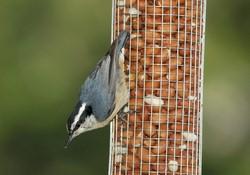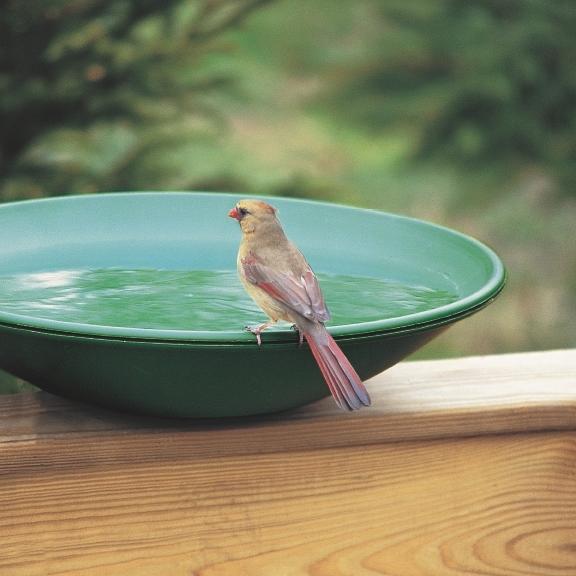The 4 Essentials for Every Backyard
Food
Nothing beats natural, native vegetation to feed the birds of your area. So plant a variety of native plants and in a combination that supplies food  year-round. Following is a list to get you started. To learn more, click on Plants for Birds and Wildlife. Also, simply the way you maintain your garden can supply additional food sources. For instance, leaves raked into your garden bed and under shrubs can provide foraging areas for ground-feeding birds such as sparrows.
year-round. Following is a list to get you started. To learn more, click on Plants for Birds and Wildlife. Also, simply the way you maintain your garden can supply additional food sources. For instance, leaves raked into your garden bed and under shrubs can provide foraging areas for ground-feeding birds such as sparrows.
Millions of people enjoy feeding birds, and feeders can help birds in especially harsh winters. A feeding station with a variety of bird feeders suited to the eating habits of different species will attract the greatest number of species. For instance, some birds feed on the ground, others like perching; some prefer sunflower seeds, others millet, thistle, suet, or nectar.
Water
Water (or the lack thereof) can be deadly serious for birds. Birds must be ready to fly at all times, and bathing is a critical part of feather maintenance and staying in top-flight condition. Whether they are feeder visitors or not, birds need water. Offering a dependable source of water is probably the  simplest and most important step you can take to greatly increase the variety of birds in your yard.
simplest and most important step you can take to greatly increase the variety of birds in your yard.
For The Heat
Water is also vitally important when it's extremely hot and a bird’s ability to regulate its body temperature can become stressed. Birds do not sweat and must remove excess body heat through their respiratory system. So when temperatures rise, a bird's respiration rate increases, sometimes to the point that it can be seen panting like a dog. This activity dehydrates birds and increases their need for a reliable source of water to replace lost fluids.
For The Cold
In winter, clean feathers help birds stay warm, and a bird bath is often the only way to drink and bathe. Research has shown that a chickadee with well-maintained feathers can sustain a 70°F (21°C) layer of insulation between the outside air and its skin. For birds and other wildlife, water is just as important in the cold months as it is during summer. If there’s no snow in your area, there is literally no water, which means birds can be in trouble. Even in places with abundant snow and ice, it costs birds precious calories and body heat to melt frozen water. Backyards that provide fresh, clean, liquid water during winter tend to host more avian visitors than do frozen yards. In winter, water is as big an attraction as feeders.
Shelter
Birds need places where they can hide from predators and inclement weather. Trees, shrubs, meadows, and even rock walls provide such shelter.
Natural sources: Native trees and shrubs of different densities and heights give birds places of retreat and safety. In winter, evergreens, hedgerows, and dense thickets offer critical cover. Place feeding stations close enough to vegetation so that birds can make a quick escape but far enough to  allow for a wide visual field for watching possible threats.
allow for a wide visual field for watching possible threats.
Supplemental sources: If your yard is lacking appropriate shelter for wildlife, create a brush pile from fallen branches and leaves. Or toss your discarded Christmas tree a few feet away from the feeder, far enough so that a lurking cat can’t pounce from behind it onto a ground-feeding bird but close enough for the birds to find speedy cover. A dry stone wall, with its nooks and crannies, or simply small piles of rocks can also provide hiding spots, as can a pile of logs. You can also erect boxes designed specifically for roosting, with the entrance hole near the bottom so that heat doesn’t escape. Mount the box in a sheltered area, preferably facing south.
Habitat to Raise Young
Birds will remain in your habitat during the breeding season if they have places to nest and raise young. Different species have different requirements. Some nest in cavities, many others in open nests found on ledges or in a tree crotch, and others nest on the ground. Get to know which species are likely to nest in your area and provide the appropriate habitat or structure. Nest boxes make a wonderful addition to a yard, allowing you to easily watch a family raise its young. Wrens, swallows, bluebirds, chickadees, and titmice are some of the species that readily use nest boxes. Identify the species of bird you’d like to attract to determine the correct size of the entrance hole needed. You may want to consider erecting a shelf-style structure for species such as robins and phoebes. Nest boxes should be mounted on a pole, fence post, or tree. Height of the nest depends on the species. For most backyard cavity nesters, a height of at least five feet is recommended. Ventilation and drainage holes are necessary, as is access to the interior to allow periodic cleaning. Baffles and metal guards to deter predators are encouraged. You can assist birds in building their nests by supplying some of the materials they seek, such as twigs; short lengths of string, yarn, and thread; cotton; hair brushed from a pet; and sphagnum moss. Leave the offerings in a tray or in an onion net bag hung from a tree.

